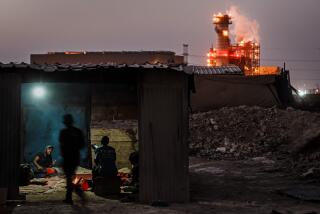Life Along Kashmir’s ‘Shooting Gallery’
- Share via
NEELUM VALLEY ROAD, Pakistan — Face down in a muddy, roadside ditch, Ahmed Younis lies small to avoid a burst of gunfire.
The first shots whiz across Pakistan’s contested border with India as the sun’s last light fades behind the towering mountains.
A 7 1/2-mile stretch of the Neelum Valley Road is the only supply route for Younis and his fellow villagers, who are caught in the cross-fire of Pakistan’s 49-year-old dispute with India over ownership of the Himalayan state of Kashmir.
Their village is just inside the part of Kashmir controlled by Pakistan, within range of Indian soldiers across the nearby border.
Vehicles haven’t been allowed on the road since September because of the sniping. Now, only the most intrepid villagers make the journey on foot to bring in food and other goods for their communities.
Short of breath and sweating despite the cold mountain air, Younis crawls on his belly toward two companions.
“We must decide if we should move next time the fire stops,” says Younis, a seasoned scout and former Pakistani soldier.
To move is to risk being spotted by Indian marksmen, but sit still too long and a stray bullet may find its mark.
The frontier has become especially dangerous because of a secessionist rebellion in the part of Muslim Kashmir controlled by Hindu-dominated India. Indian troops deny targeting civilians, saying they shoot only at people suspected of trying to smuggle arms to the rebels.
Indian authorities say Pakistani soldiers also fire across the border, sometimes hitting civilians. But many border villages on the Indian side have been cleared out because India believes the residents were helping militants cross the frontier.
In this stretch, known as “the shooting gallery,” the road runs adjacent to the frontier, the flash point of two wars between Pakistan and India.
Bending with the turns of the Neelum River, the road skirts the water--a natural dividing line between India and Pakistan.
Moments pass and another burst of machine-gun fire explodes. Younis whispers a brief prayer. Another bullet and then another ricochet off some rocks just above and ahead.
Tracer bullets zing across the border trailing red and yellow streaks that seem to hang in the air.
Younis hunches deeper into the wet, shallow ditch, which offers the only cover from the shooting.
Last year, the bodies of more than 200 civilians were recovered from the river, according to both the Pakistan army and United Nations.
Countless others have been wounded, but for the villagers the choice is clear.
“We have to get food into the village,” says Haji Nausherwan, who hasn’t made the journey for more than six months. A bullet shredded the muscles in his right thigh last year.
Since the start of this year, 28 Pakistanis have been killed trying to bring food and fuel into the isolated village of Authmuqam.
For Younis, there is a gnawing fear lying in the cold rain as bullets whiz past.
Slowly he inches ahead to peer around a bend. Returning to gather his 50-pound pack, he whispers: “We must go. It’s too dangerous to stay for long.”
He explains that his group of three men will separate and walk one at a time in intervals of about 50 yards to clear the most dangerous stretch ahead: a 200-yard expanse.
It’s a hairpin turn that leaves all traffic completely exposed to Indian snipers from their posts dotting the hilltops overlooking the Neelum River.
The nearly full moon casts weird shadows, and Younis’ shape melds into the background as he moves forward. Soon he is little more than a blurred silhouette gliding against the mountainside.
He stops short at the turn in the road and explains that the closest Indian bunker--just 260 feet across the Neelum River--has fixed its gun sights on the next few feet of road.
“If they are watching, they can easily shoot anything that passes through this section,” Younis says.
There is no cover, only a 1,100-foot drop to the riverbed on one side of the road and sheer rock face on the other.
Creeping along, one at a time, Younis’ group takes more than an hour to cross the 200 yards.
Once past, hands shaking, one man lights a cigarette and slumps to the ground in relief. The remaining half mile can be done in relative safety as the road moves back from the disputed border.
In another 20 minutes, Younis reaches the village of Jura, where he hands over his pack to the driver of a small Jeep headed for Authmuqam.
Younis rests for a moment, bids farewell to his companions and heads back toward “the shooting gallery” to bring in more supplies.
More to Read
Sign up for Essential California
The most important California stories and recommendations in your inbox every morning.
You may occasionally receive promotional content from the Los Angeles Times.













